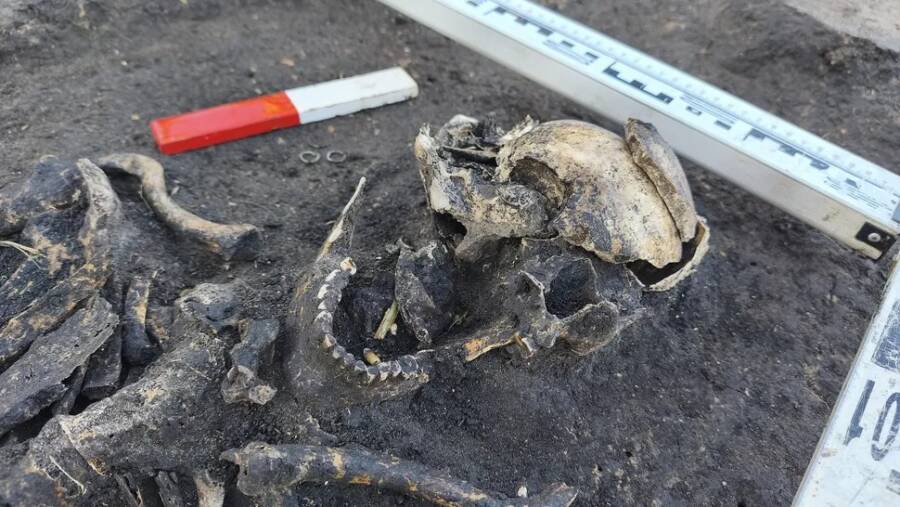Gas Pipeline Workers In Poland Just Found A Medieval Cemetery Filled With 24 Men Buried Alongside Their Weapons
Katarzyna AlagierskaArchaeologists found 24 sets of remains in the cemetery that was uncovered in Borkowo.Archaeologists in Poland have uncovered a cemetery from the 10th century containing the remains of more than 20 people who may have been some of the first Christians in the region and may have also been elite warriors.The cemetery was discovered during construction work for a gas pipeline in Borkowo. The remains date back to when people in this area began converting from paganism to Christianity, which is reflected in the way these people were buried.While preliminary dating has placed the remains as being from the time of Mieszko I the duke credited with unifying the country and creating the first Polish state and experts believe that these skeletons may have belonged to his fabled Piast warriors, much remains to be uncovered about this astonishing find.The Chance Discovery Of One Of Polands First Christian CemeteriesKatarzyna AlagierskaThe cemetery could hold the remains of elite warriors, perhaps linked to Polish ruler Mieszko I.The cemetery was found near the remains of a medieval settlement, and according to Science in Poland, archaeologists believe these 24 skeletons likely belonged to residents of this stronghold or possibly warriors from the garrison meant to protect it.Alongside the remains, archaeologists also found various grave goods, including arrowheads, a battle axe, knife blades, rings, and red carnelian beads. This further suggests that these people were both warriors and elites.Furthermore, this site dates back to the 10th century, when pagan communities in this region first began converting to Christianity. Archaeologists think this transition is reflected in the specifics of these recently-discovered burials.We view these people as representatives of the first Christians in these lands, Justyna Marchewka-Dugoska, a member of the research team, told Live Science.For starters, the very act of burying these bodies, as opposed to burning them, suggests a Christian influence and not a pagan one. However, burying the dead alongside various grave goods was a much more common practice within paganism, as opposed to Christianity. Additionally, the burials were not arranged in the typical rows seen in medieval cemeteries, instead appearing to be placed at random, a fact that has left researchers puzzled.This hybrid approach suggests the cemetery dates back to a time when this areas religious practices and customs were changing slowly but surely.The introduction of a new worldview is not a revolution, but an evolution, Marchewka-Dugoska explained. Perhaps the form of the burials from Borkowo and the fact that they are quite richly equipped reflect this slow shift in worldview.Do These Remains Belong To The Famed Piast Warriors Of Mieszko I?Katarzyna AlagierskaThe skeletons will undergo further analysis so that researchers can learn more about who exactly they were.Preliminary dating suggests that the cemetery was created sometime in the 10th century. This coincides with the rule of Mieszko I, who built the first unified Polish state and ruled from 960 to 992 C.E.In fact, some researchers have theorized that this cemetery was a mass burial of Mieszko Is storied Piast warriors, though this claim remains unverified for now.Historically, we do not yet know whether we can discuss any connections at all, Marchewka-Dugoska told Live Science, regarding any possible connection to Mieszko I. For now, the skeletons have been collected and are awaiting anthropological analysis.While these remains may not belong to Mieszko Is specific class of warriors, some of the skeletons do show evidence of trauma and other wear-and-tear commonly seen among soldiers. Early analysis revealed evidence of a healed rib fracture in one of the skeletons. Another showed skeletal evidence of repeated horse-riding. Whats more, all of these remains come from, as the researchers put it, tall, robust individuals well-built men who commanded respect.But much remains to be uncovered, and researchers hope that further analysis will reveal more about who these people were and what kind of roles they may have served in the nearby settlement.After reading about the medieval remains found at a cemetery in Borkowo, see the 17th-century vampire remains uncovered in Poland. Then, learn about the 25 childrens graves found at a medieval German chapel.The post Gas Pipeline Workers In Poland Just Found A Medieval Cemetery Filled With 24 Men Buried Alongside Their Weapons appeared first on All That's Interesting.


